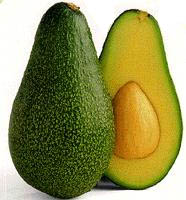Avocado
Appearance
| Avocado | ||||||||||||
|---|---|---|---|---|---|---|---|---|---|---|---|---|
 Avocado fruit and foliage, Huntington Library, California
| ||||||||||||
| Scientific classification | ||||||||||||
| ||||||||||||
| Binomial name | ||||||||||||
| Persea americana Mill. |
| Avocado, raw (edible parts) Nutritional value per 100 g (3.527 oz) | |||||||||||||||||||||||||||||||||||||
|---|---|---|---|---|---|---|---|---|---|---|---|---|---|---|---|---|---|---|---|---|---|---|---|---|---|---|---|---|---|---|---|---|---|---|---|---|---|
| Energy 160 kcal 670 kJ | |||||||||||||||||||||||||||||||||||||
| |||||||||||||||||||||||||||||||||||||
| Percentages are relative to US recommendations for adults. Source: USDA Nutrient database | |||||||||||||||||||||||||||||||||||||
Explanation
[alilan ya ing pikuwanan]- Required variables: name, kJ, carbs, fat, protein. Supply units (except for kJ which is in kJ).
- Optional variables: sugars, lactose, satfat, transfat, monofat, polyfat, omega3fat, omega6fat, fiber, fibre, starch, water, alcohol, caffeine. Supply units (normally g).
- Optional freeformat variables (name and value): opt1n, opt1v, etc. up to opt4n and opt4v.
The following optional variables are converted into percentages of RDA (taken as averages for males and females aged 25-50 years from the USDA 2000 recommendation):
- Optional minerals (in mg): calcium_mg, iron_mg, phosphorus_mg, magnesium_mg, sodium_mg, potassium_mg, zinc_mg
- Optional vitamins (in mg, μg, or international units): vitA_ug, thiamin_mg (Vit. B1), riboflavin_mg (Vit. B2), niacin_mg (Vit. B3), pantothenic_mg (pantothenic acid), vitB6_mg, folate_ug, vitB12_ug, vitC_mg, vitD_ug, vitD_iu (in IU), vitE_mg, vitK_ug.
Other optional variables and flags:
- Optional footnote: note
- Optional data source: source, or as a flag: source_usda=1 for the USDA database
- Optional suppression of RDA explanation: noRDA=1
- Optional flags: right=1 (table will be floating on the right)
Further remarks:
- According to convention, there should be a space between the number and the unit: "14 g" and not "14g".
- Splitting up components that are present in trace amounts is not very meaningful (e.g. 1.5 g fats of which 0.5 g unsaturated).
- The author of the template recommendeds to include only vitamins and minerals for which this product is considered to be a major source, in order to prevent clogging up the article with a huge table. As a guideline:
- staple foods: an amount that provides 10,000 kJ should provide well over 100% of the RDI.
- meats and such: same, but for 4,000 kJ.
- vegetables, other low-calorie solid food, fruits: same, but for 400 g.
- other products: use an amount that one could reasonably eat on a daily basis.
Nutritional values can be found e.g. in the USDA National Nutrient Database. Note that fibers are counted as carbohydrates.
Template editing
[alilan ya ing pikuwanan]Don't put linebreaks into the template around the {{#if:...}} parser functions, because they will end up as linebreaks above the table.
Maybe someone can do this in wikitable format rather than raw HTML, if you know how to combine that with the {{#if: }} conditionals. Please experiment in Template:NutritionalvalueTest to prevent breaking article pages.
See also
[alilan ya ing pikuwanan]- {{Nutritional information}}
- {{Nutrition Facts}}
- {{Foodbox}}
</noinclude>



References
[mag-edit | alilan ya ing pikuwanan]External links
[mag-edit | alilan ya ing pikuwanan]
Ing Wikimedia Commons atin yang mediang maki kaugnayan kang/king:
- Nutritional information
- Avocado.org Archived Juliu 15, 2006 at the Wayback Machine (from California)
- University of California Agriculture Explanation of the Avocado Fruit's Classification as a Berry (and not a Drupe).
- Avocadosource.com Online Library of Avocado Research Papers.
- California Rare Fruit Growers Archived Nobyembri 7, 2006 at the Wayback Machine, avocados beyond Persea americana
- ASPCA - Animal Poison Control Center
- Avocado Cooking Tips and Hints Archived Oktubri 18, 2006 at the Wayback Machine

